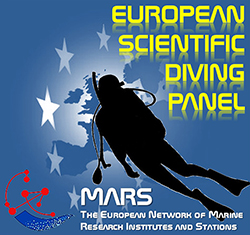THE ADVANCED EUROPEAN SCIENTIFIC DIVER (AESD) | to ESD standards
An Advanced European Scientific Diver is a diver capable of organizing a scientific diving team. He/she may attain this level by either a course or by in-field training and experience under suitable supervision or by a combination of these two methods.
The AESD must:
- show proof of theoretical knowledge and a comprehensive understanding of:
- Diving physics and physiology, the causes and effects of diving related illnesses and disorders and their management.
- The specific problems associated with diving to and beyond 30m, calculations of air requirements, correct use of decompression tables.
- Equipment, including personal dive computers and guidelines as to their safe use.
- Emergency procedures and diving casualty management.
- The principles and practice of dive planning and the selection and assessment of divers.
- Legal aspects and responsibilities relevant to scientific diving in Europe and elsewhere.
- Dive project planning.
- Be fully competent with/in:
- Diving first aid, including CPR and oxygen administration to diving casualties.
- SCUBA rescue techniques and management of casualties.
- The use and user maintenance of appropriate SCUBA diving equipment, including dry suits and full face masks.
- Basic small boat handling, and electronic navigation.
- Supervision of diving operations.
- Be fully competent with:
- Search methods, such as those utilizing free swimming and towed divers together with remote methods suitable for a various range of surface and sub-surface situations.
- Survey methods, both surface and sub-surface, capable of accurately locating and marking objects and sites.
- The basic use of airbags and airlifts for controlled lifts, excavations and sampling.
- Basic rigging and rope work, including the construction and deployment of transects and search grids.
- Underwater navigation methods using suitable techniques.
- Recording techniques.
- Roped/tethered diver techniques and various types of underwater communication systems such as those utilizing visual, aural, physical and electronic methods.
- Sampling techniques appropriate to the scientific discipline being pursued.
- Show proof of having undertaken 100 open water dives, to include a minimum of:
- 50 dives with a scientific task of work, such as listed above.
- 20 dives deeper than 20m of which 10 dives deeper than 29m
- 12 dives in the last 12 months, including at least 6 with a scientific task of work.
- 20 dives in adverse conditions, such as currents, cold water, or moving water.
- 20 dives as an in-water dive leader.
All evidence must be recorded in nationally acceptable logs, countersigned by suitably qualified persons. None of the above precludes the possible requirement for a practical or theoretical demonstration of any or all of the points shown.
